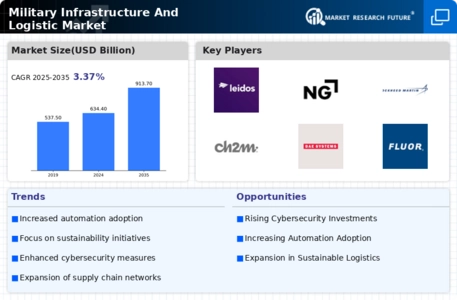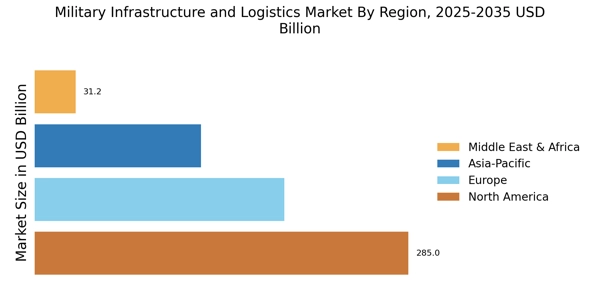Geopolitical Tensions
Geopolitical tensions are a significant driver of the Military Infrastructure And Logistic Market, as nations respond to evolving security threats. Heightened military activities in regions experiencing conflict or instability lead to increased demand for robust logistics and infrastructure support. For instance, recent military exercises and troop deployments have necessitated the expansion of logistics networks to ensure rapid mobilization and supply chain resilience. This trend is likely to persist, as countries invest in infrastructure to support their military operations in response to perceived threats. Consequently, the Military Infrastructure And Logistic Market is poised for growth as nations prioritize strategic logistics capabilities.
Increased Defense Budgets
The Military Infrastructure And Logistic Market is experiencing a notable surge in defense budgets across various nations. Governments are prioritizing military spending to enhance their defense capabilities, which directly impacts infrastructure and logistics investments. For instance, recent data indicates that defense budgets have increased by an average of 3-5% annually in several countries, reflecting a commitment to modernizing military assets. This trend is likely to drive demand for advanced logistics solutions, including transportation, supply chain management, and maintenance services. As nations seek to bolster their military readiness, the Military Infrastructure And Logistic Market stands to benefit significantly from these increased allocations.
Technological Advancements
Technological advancements are reshaping the Military Infrastructure And Logistic Market, introducing innovative solutions that enhance operational efficiency. The integration of artificial intelligence, automation, and data analytics is streamlining logistics processes, enabling faster decision-making and improved resource allocation. For example, the adoption of AI-driven supply chain management systems has shown to reduce operational costs by up to 20%. Furthermore, advancements in communication technologies facilitate real-time tracking of military assets, ensuring timely delivery and optimal utilization. As these technologies continue to evolve, they are expected to play a crucial role in transforming the Military Infrastructure And Logistic Market, making it more agile and responsive to emerging challenges.
Focus on Readiness and Resilience
The emphasis on military readiness and resilience is driving investments in the Military Infrastructure And Logistic Market. Nations are increasingly recognizing the importance of maintaining operational capabilities in the face of potential disruptions, whether from natural disasters or geopolitical conflicts. This focus has led to the development of more resilient logistics systems that can withstand various challenges. For example, military organizations are investing in redundant supply chains and alternative transportation routes to ensure continuity of operations. As this trend continues, the Military Infrastructure And Logistic Market is likely to see increased demand for solutions that enhance resilience and adaptability in logistics operations.
International Collaboration and Partnerships
International collaboration and partnerships are emerging as key drivers in the Military Infrastructure And Logistic Market. Countries are increasingly engaging in joint military exercises and collaborative logistics initiatives to enhance interoperability and efficiency. Such partnerships often lead to shared resources and knowledge, which can optimize logistics operations. For instance, multinational exercises have demonstrated the effectiveness of coordinated logistics efforts, resulting in improved response times and resource utilization. As nations seek to strengthen their alliances and improve operational capabilities, the Military Infrastructure And Logistic Market is expected to benefit from these collaborative efforts, fostering innovation and efficiency in military logistics.


















Leave a Comment